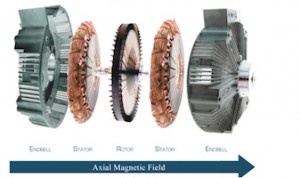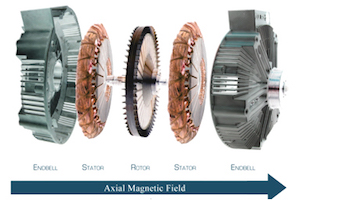Lewis H. is a like-minded Squirrel. He wrote to me to remind me that in an emergency our vehicle can be a powerful option for home electricity. He says:
One major point no one mentions is fuel-car-generator-electrical power combination when the grid is down.
 Look up AuraGen on the web. The AuraGen or VIPER (VIPER is the name used by the US military) is an integrated, mobile power generator and power management system that installs in a motor vehicle and delivers, on-location, both AC and DC electricity for any end user application. Its official description is a “solid rotor axial flux induction machine.”) This induction power machine hooks up under the hood of any vehicle, runs off its engine at any rpm, and generates computer grade *good* power. Lewis says that many of these devices are sold to police, sheriff, ambulance/EMT vehicles where they need good power in the vehicle, as well as to contractors so they can run power saws etc. on the job site from their truck.
Look up AuraGen on the web. The AuraGen or VIPER (VIPER is the name used by the US military) is an integrated, mobile power generator and power management system that installs in a motor vehicle and delivers, on-location, both AC and DC electricity for any end user application. Its official description is a “solid rotor axial flux induction machine.”) This induction power machine hooks up under the hood of any vehicle, runs off its engine at any rpm, and generates computer grade *good* power. Lewis says that many of these devices are sold to police, sheriff, ambulance/EMT vehicles where they need good power in the vehicle, as well as to contractors so they can run power saws etc. on the job site from their truck.
Feeding power to your home from your car
As well as the AuraGen, you will need a very simple modification to your home electrical system to connect select items, like a freezer, refrigerator, microwave, or medical device and a few selected wall outlets to an “emergency panel.” (Get a qualified electrical contractor to do the design work and a certified electrician to do the installation of the new panel. It’s quick and easy but it’s important to get it done right to minimize the threat of fire or electrical shock.)
Under normal conditions, grid power feeds into your main panel, which includes this emergency panel. When the grid goes down, you connect an extension cord (from AuraGen) to the emergency panel and to your vehicle. The power from your vehicle and the AuraGen feed into the emergency panel and from there to the desired electrical outlets.
It’s not strong enough to power everything in your home but you can rotate devices as you need them. Keeping the freezer on for a few hours every 24 hours for instance and while that’s not running you try and run your home communications system or microwave or lamps.
Warning – – if times are really tough (e.g.the grid is down long time,) it’s not a good idea to “advertise” that you have power (lights on) because that would tempt looters to come see what else you have worth stealing. Lewis says, you should clean out enough of your garage to let the vehicle actually be in the garage (what a radical concept!) Get an exhaust hose, run it from the exhaust pipe out through a hole in the back of your garage (away from the street) for exhaust that will not draw attention. Good black-out curtains in a few rooms will ensure you have some sort of normal life by lamplight while not inviting looters.
Gas
Modern vehicles, at idle, will run for very long time on one tank of gas. But you are not going to run vehicle non-stop, only as needed to keep freezer and refrigerator at design temperature (get some good thermometers and keep them inside both, check to maintain freezer at or near zero and fridge in mid 30s). Then off for a while, on to cook a microwave meal, then off. On to run wall outlets that charge rechargeable batteries for lamps in those blackout curtain rooms.
But even *run a long time* is only good for as long as you have fuel for vehicle. Make it a habit to always keep vehicle as full as possible- – hit the gas station when nearly down to 3/4 full so you start any emergency situation with a full or nearly full gas tank.
Gasoline storage is not always easy. But the problem is easily solved. Rotate your supplies. Buy half a dozen (or more based on your estimate/analysis of how much/how long you might need to depend on your car for electricity) five-gallon gasoline containers. Fill one or two at a time, at different gas stations, till you have all full. From now on, you are your own gas station as far as filling the car is concerned. Down near 3/4 full? Fill up from one of those five gallon cans. Take it with you on a normal errand and refill it. Arrange all the gas cans in a row, and put that ‘just-filled” can at the back of the line. By using fuel in each can, in line, in turn, you are roatating your fuel stocks and not letting any “go bad” from storing too long.
So here you are, your vehicle is running quietly in your garage, your exhaust is going through a hose safely out a hole in back of the garage, fuel is being rotated and electricity is available to keep your freezer and fridge at cold temps, cook a microwave meal, use your computer to retrieve all the good stuff you have stored there, and have some lights in a secluded portion of your house.
One major benefit of my idea is to eliminate the serious fire risk involved with trying to refuel a portable generator, spilling fuel and possibly having that fuel ignite when it hits a very hot metal part on that generator. Using a gas can with a nozzle makes putting gas in the car’s gas tank a spill-proof, foolproof method of refueling. And, the “hot engine parts” are a long way away from any possible spill. If five gallon gas cans are too heavy for you, three-gallon cans (but get more of them) will be easier to handle. Also, that smaller size is a more normal size for the average home owner to be using to run their lawnmower in the summer or their snowblower in the winter, so filling a three gallon gas can or two will attract less attention.
I emailed AuraGen but they haven’t got back to me. I’ll keep on them and I’ll let you know what I can find out and how we might be able to get these babies into fellow Squirrels’ paws.

